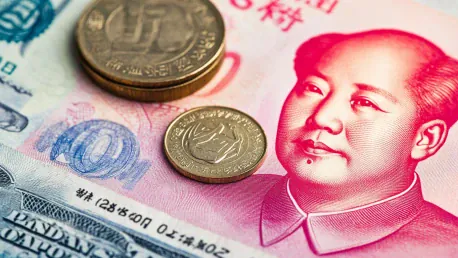China’s economic data, particularly its Balance of Payments (BoP) figures, have long been a subject of scrutiny and skepticism. This article delves into the inconsistencies and credibility issues surrounding these figures, exploring the implications for global economic assessments and policy recommendations.
The Importance of Reliable Economic Data
Credibility Concerns
China’s economic data, particularly its Gross Domestic Product (GDP) and Balance of Payments (BoP) figures, have long been scrutinized for potential manipulation aimed at meeting targets. This skepticism is particularly directed at China’s GDP data, which often appear extraordinarily smooth and consistent, prompting doubts about their credibility. Historically, the BoP data were viewed more favorably due to the availability of independent verification through trade partner data. This extra layer of oversight provided a check against potential discrepancies in reported numbers.
However, recent years have witnessed a decline in the trustworthiness of China’s BoP data. Increasingly, economists and analysts are raising alarms about potential inconsistencies and adjustments that seem to lack a clear and justifiable basis. The result is a growing chorus of voices advocating for more transparent data practices to restore confidence. Reliable economic data are crucial not just for academic analysis but also for practical policy formulation by international bodies such as the IMF. When these data are questionable, the ripple effects can disrupt not only national economies but also the broader global financial landscape.
Impact on Global Assessments
Accurate and reliable economic data are vital for the International Monetary Fund (IMF) and other global organizations in formulating effective policies that aim to stabilize and enhance economic performance. Discrepancies and inconsistencies in China’s BoP data can lead to erroneous policy recommendations, affecting not only China’s economy but also global economic stability. These inaccuracies can skew the perception of China’s economic health and distort the bases on which international financial institutions make crucial decisions.
When economic data from a major player like China are questionable, the consequences can be far-reaching. Faulty statistics can mislead global entities into adopting policies that might not be suitable for the actual economic climate. For instance, if the data exaggerate the strength of China’s economy, it could lead to recommendations for policies that prioritize cooling off an overheating economy. Conversely, if the data understate economic performance, it could result in recommendations that strive to stimulate an economy that doesn’t need such measures. This makes the need for credible and transparent economic data not just essential but a responsibility for all nations, particularly those of significant economic influence.
Discrepancies in Balance of Payments Reporting
Trade Surplus vs. BoP Surplus
One of the most glaring inconsistencies in China’s economic reporting lies in the substantial divergence between its reported customs goods surplus and its BoP surplus. China’s customs data indicate a goods surplus of approximately $1 trillion, a figure that aligns reasonably well with data reported by its trading partners. Yet, this enormous surplus dwindles to around $400 billion when represented in the BoP data. This stark reduction has raised questions about the methodologies employed to convert customs data into BoP statistics.
The way that China translates its customs surplus into its BoP surplus involves complex adjustments that are not entirely transparent or consistent with standard economic principles. Historically, these adjustments might have accounted for factors such as shipping and insurance costs, which would only slightly alter the surplus figures. However, in recent times, the adjustments have become more opaque and far-reaching, leading to a substantial decrease in the reported BoP surplus relative to the customs surplus. This significant discrepancy highlights potential manipulation or methodological flaws, casting doubt on the reliability of China’s economic data reporting.
Methodological Changes
A significant factor in the reported discrepancies is the series of methodological changes that China has introduced in converting its customs surplus into the BoP surplus. These changes have resulted in a substantial reduction in the reported BoP surplus by approximately $200 billion. This shift from relying on independently verifiable customs data to an internal payments data series has significant implications for the transparency and accuracy of the reported figures.
The transition to using internal payments data has drawn considerable criticism due to the opacity and the potential for data manipulation it introduces. Independent verification becomes exceedingly difficult, if not impossible, thereby undermining the credibility of the figures presented. This change erodes the confidence that international economists and policymakers place in the BoP data, making it challenging to form accurate global economic assessments. The lack of transparency and the potential for data to be adjusted according to internal metrics, without external confirmation, represent a significant departure from internationally accepted practices. This divergence severely impacts the ability of global entities to trust and utilize China’s reported economic data effectively.
Adjustments Impacting the Goods Balance
Historical Adjustments
In the past, adjustments from China’s customs balance to the Balance of Payments (BoP) were minor and straightforward, typically accounting for factors such as shipping and insurance costs. These adjustments were fairly transparent and did not significantly alter the reported figures. This practice allowed for a reasonable degree of trust in the BoP data, as the reported figures generally matched the independently verifiable customs data with only slight modifications needed for proper economic accounting.
However, this historical clarity has given way to increasingly complex and less transparent adjustments. This shift raises questions about the motivations and accuracy behind the reported figures. While minor adjustments like accounting for transportation and logistical costs are standard practice and easily understood, more recent adjustments have introduced significant discrepancies that are not as easily explained. This change has led to concerns about the potential for economic data to be manipulated or misreported, undermining the reliability that international analysts and policymakers previously attributed to China’s economic statistics.
Recent Adjustments
Recent adjustments to China’s BoP figures imply that the reported export data may include inflated figures due to the pricing mechanisms of contract manufacturing businesses, such as the production of Apple iPhones in China. The argument posits that the customs data are skewed by inflated prices reported by these factories, thus necessitating significant adjustments to arrive at a more accurate BoP figure. However, upon closer examination, this explanation lacks substantiation and coherence when cross-referenced with actual export pricing data.
Critically analyzing the export data for major categories reveals that the prices reported in customs data are consistent with known production costs and global pricing structures. This consistency suggests that the adjustments made to BoP figures, which drastically reduce the reported surplus, may not be justified by factual export pricing mechanisms. This discrepancy further compounds the skepticism surrounding China’s economic data reporting, suggesting that the reductions might be an attempt to present a more strategically favorable economic picture rather than a reflection of actual economic activity. Such manipulations can lead to significant misinterpretations and misinformed policy decisions on a global scale, making transparency and independent verification more crucial than ever.
Income Derived from External Assets
Reported Investment Income Deficit
Another noteworthy inconsistency in China’s economic reporting is the apparent deficit in investment income, which seems counterintuitive given the country’s significant external assets. Despite China’s extensive investments abroad and the overall increase in global interest rates, the nation reports an investment income deficit. This anomaly stands in stark contrast to other surplus countries, which have reported gains from their overseas investments driven by favorable interest rate environments.
The reported deficit raises questions about the accuracy and integrity of China’s investment income data. Given the global economic conditions and the typical returns on foreign investments, it is reasonable to expect China to show a surplus in this category. Instead, the reported deficit suggests either an understatement of actual returns or a misrepresentation of the data. This inconsistency becomes more alarming when considering the scale of China’s external assets and the potential for these figures to significantly influence global economic assessments and policy decisions. The reported investment income deficit not only distorts the perception of China’s economic health but also affects the broader understanding of global capital flows and investment dynamics.
Potential Underreporting
The likely underreporting of returns from China’s extensive external investments has significant implications for global economic assessments. If China’s actual returns are higher than the reported figures, as suggested by the examination of investment income data, this underreporting can falsely skew global economic analyses and the resulting policy recommendations. Accurate reporting is crucial for international entities to understand the true scale and impact of China’s external investments.
Underreporting of investment returns can also influence international financial markets, as it affects perceptions of China’s economic resilience and capacity to influence global financial stability. Misrepresented data can lead to either overestimation or underestimation of China’s economic strength, impacting foreign direct investments, exchange rates, and international policy frameworks. This makes it imperative for international bodies to scrutinize and challenge the reported figures, ensuring that policies are based on accurate, transparent, and verifiable data. The potential underreporting of China’s investment income not only distorts the global economic picture but also complicates the formulation of effective and impactful economic policies.
Implications for Policy and Economic Interpretation
IMF’s Role
The International Monetary Fund’s (IMF) role in accepting China’s reported data without exhaustive verification has been criticized for potentially contributing to misguided policy recommendations. The size of China’s current account surplus, as reported, plays a crucial role in shaping global economic assessments and policy formulations. The substantial discrepancies and lack of transparency in these figures call for a rigorous reevaluation of their accuracy and legitimacy.
If the IMF relies on potentially manipulated or unverified data, the policy advice it provides might not align with the actual economic conditions. For instance, unverified surpluses can lead to recommendations aimed at curbing inflation or managing possible capital outflows which might be unnecessary based on the real economic scenario. Conversely, underreported surpluses might obscure the need for policies that stimulate domestic demand or address other economic challenges appropriately. This makes the scrutiny of reported data crucial for formulating policies that accurately reflect the economic reality, ensuring that the IMF’s policy recommendations drive effective and appropriate actions.
Need for Transparency
There is a growing consensus among economists and policymakers on the critical need for greater transparency and verifiability in China’s economic data reporting. Transparent and reliable data are essential for the formulation of effective policy, both within China and globally. When economic figures are subject to scrutiny and independent verification, it ensures that policies are based on a robust and accurate understanding of the economic landscape.
Without transparency, the credibility of the data is severely compromised, leading to potential misjudgments and inappropriate policy measures. Independent verification mechanisms can help bridge this gap, offering a more accurate and dependable economic picture. This level of scrutiny not only bolsters confidence in the reported figures but also enhances the global economic framework’s ability to respond to and manage international economic dynamics effectively. The call for transparency is not merely about access to data but also about ensuring that the data reported are reflective of actual economic activities and conditions, facilitating better-informed decision-making at both national and international levels.
Overarching Trends and Consensus Viewpoints
Skepticism About Data Reliability
The reliability of China’s economic data has long been a topic of debate, with skepticism surrounding the credibility of the figures being echoed by multiple analysts and economists. This distrust is particularly pronounced when it comes to the adjustments and revisions seen in China’s BoP data. The pattern of smooth and consistent GDP growth figures further exacerbates doubts about potential data manipulation designed to meet specific economic targets.
The skepticism is not limited to China’s BoP data; it extends to multiple aspects of China’s economic reporting, including investment income and trade surplus figures. This overarching distrust compromises the ability of global economic entities to rely on China’s reported figures for accurate economic assessments and policy formulations. The persistent concerns about data reliability stress the urgent need for reforms in how China reports its economic data, ensuring that these figures can be trusted and utilized effectively in shaping global economic strategies.
Global Economic Impacts
The reliability of China’s reported current account surplus figures plays a critical role in shaping international economic policy and stability. The International Monetary Fund’s policy recommendations hinge on these figures, making the ambiguity and potential understatement of surplus figures cause for significant concern. If China’s surpluses are indeed understated, the policy advice given by the IMF might not align with the actual economic conditions, leading to potential missteps in addressing global economic challenges.
Inaccurate data can have profound implications, potentially guiding policies that are either too aggressive or too lenient, based on a misinterpreted economic reality. For instance, understated surplus figures might prompt policies that aim to stimulate an already sufficiently robust economy, leading to overheating or misallocated resources. These misguided policies can have cascading effects, influencing global trade dynamics, capital flows, and overall economic stability. Ensuring the reliability of China’s economic data is not just a matter of national concern but a global imperative, affecting the financial health and stability of economies worldwide.
Conclusion
Summary of Findings
The analysis highlights significant concerns regarding the transparency and accuracy of China’s reported economic data, particularly its Balance of Payments (BoP) figures. These inconsistencies, coupled with the lack of transparency in the methodologies employed, cast doubt on the credibility of the reported data. The findings emphasize the critical need for verifiable data to ensure precise global economic assessments and effective policy formulation. The impact of these discrepancies extends beyond China, affecting international economic stability and the accuracy of policy recommendations by global entities such as the IMF.
Call to Action
China’s economic data, especially its Balance of Payments (BoP) figures, have consistently been in the spotlight, often met with scrutiny and doubt. This article delves into the inconsistencies and credibility issues surrounding China’s BoP numbers. The accuracy of these figures is vital for understanding the true state of the global economy, influencing decisions and policies made by countries and organizations worldwide.
Scrutinizing China’s BoP statistics reveals several discrepancies that raise questions about their reliability. These figures are crucial because they give insights into China’s economic health, affecting everything from international trade negotiations to foreign investment decisions. When these numbers are inconsistent or misrepresented, it can lead to misguided policy decisions, impacting global economic stability.
The article examines the reasons behind these inconsistencies, such as potential political motivations or methodological differences. It also discusses the broader implications for global economic assessments and policy recommendations. By understanding the credibility issues with China’s BoP data, policymakers and analysts can make more informed decisions, leading to better outcomes for the global economy.









